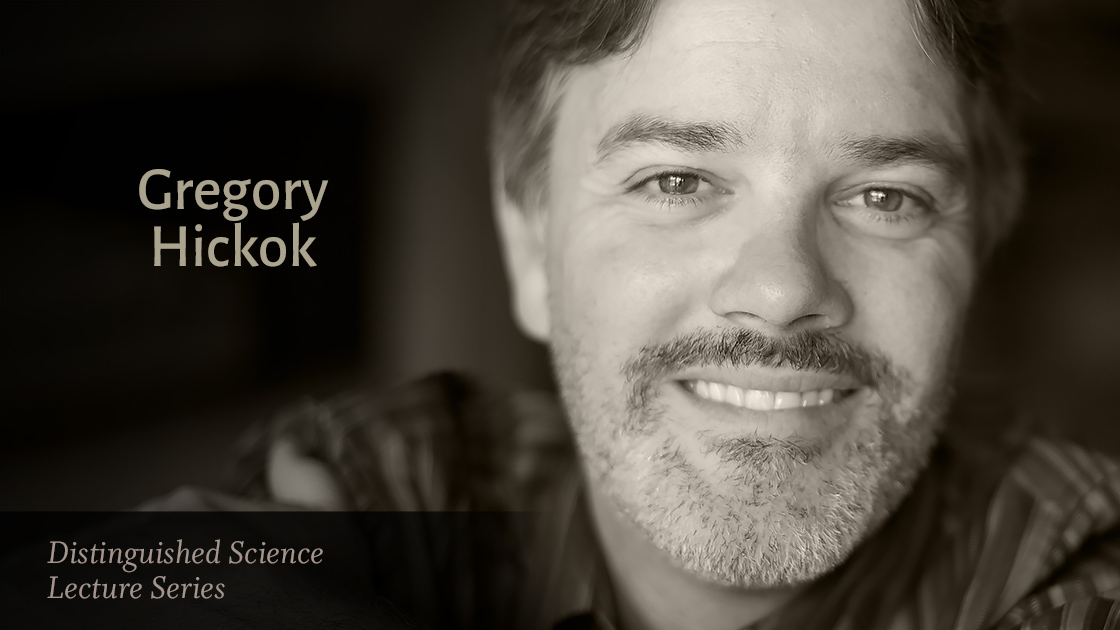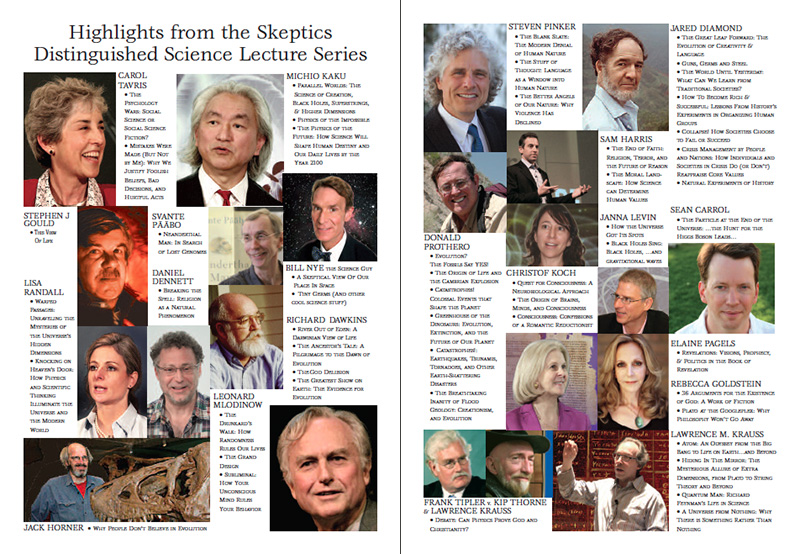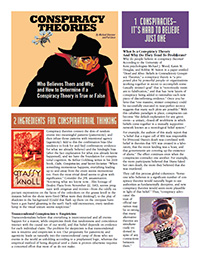In this week’s eSkeptic:
- Distinguished Science Lecture: Dr. Gregory Hickok — The Myth of Mirror Neurons
- A message from Michael Shermer: Science Lectures to the Masses
- Big Name. Bigger Ideas.: Download Highlights from Our Lecture Series
- Free Download: Conspiracy Theories Booklet: The Who?, Why? and How?
- Feature: What is the Ant, Sir?
DISTINGUISHED SCIENCE LECTURE
Dr. Gregory Hickok — The Myth of Mirror Neurons
In this myth-busting talk based on his new book, U.C. Irvine cognitive scientist Dr. Gregory Hickok calls for an essential reconsideration of one of the most far-reaching theories in modern neuroscience and psychology. Ever since the discovery of mirror neurons in macaque monkeys in 1992 there has been a stream of scientific studies implicating mirror neurons in everything from schizophrenia and drug abuse to sexual orientation and contagious yawning. Drawing on a broad range of observations from work on animal behavior, modern neuroimaging, neurological disorders, and more, Hickok argues that the foundational assumptions fall flat in light of the facts. Read more…. Order The Myth of Mirror Neurons from Amazon.
You play a vital part in our commitment to promote science and reason. If you enjoyed this Distinguished Science Lecture, please show your support by making a donation.

Be part of bringing the Skeptics Society’s Distinguished Science Lecture Series at Caltech to the world
Fellow skeptics,
Since 1992, the Skeptics Society has sponsored the Distinguished Science Lecture Series at Caltech, one of the premiere scientific institutions in the world, hosting over 350 of the biggest names in science. This series of lectures has covered the most advanced, leading-edge discoveries, and controversial topics in all of science, and enabled students, educators, and the general public to hear what’s new in science and skepticism. These lectures have helped people learn how to think critically about claims made in the name of science.
Now we want to take the Distinguished Science Lecture Series to a whole new level. While ticket, book, and DVD sales have provided enough funding to bring these cutting-edge ideas to tens of thousands of people, we would like to make them available to a much broader audience—to millions…to the world.
Following the TED model (I have given two TED talks that have been viewed by almost six million people), we are looking for a major donor/sponsor to reach this goal. Our speakers are just as prestigious as TED speakers—and our speakers’ talks are more in depth at full hour-long lectures—so there is every reason to believe that we too can reach millions of people around the world with our remarkable speakers and lectures.
A quality product on the Internet is, of course, a means to this end. We want to make our lectures available to everyone in the world who has Internet access by live streaming the events and then posting them shortly thereafter at Skeptic.com for viewing in the future. We would like to make this service available for free for viewers. To this end we have a detailed line-item budget available upon request and look forward to working with a major donor/sponsor to help take the Distinguished Science Lecture Series to the next level. We want to change the world, and in order to do that we need to make science and skepticism available to everyone in the world.
Sincerely,
Michael Shermer
Click the graphic below to download a printable PDF version of highlights from our Distinguished Science Lecture Series
We need your support.
Please be a part of bringing our Distinguished Science Lecture Series at Caltech to the world, by making a tax-deductible donation online using your credit card, or by downloading a printable donation card to make your donation by cheque. You may also make a donation by calling 1-626-794-3119. The Skeptics Society is a 501(c)(3) nonprofit educational organization. All donations are tax deductible.

Conspiracy Theories
Who Believes Them, and Why? How Can You Determine if They are True or False?
What is a conspiracy theory, why do people believe in them, and why do they tend to proliferate? Why does belief in one conspiracy correlate to belief in others? What are the triggers of belief, and how does group identity factor into it? How can one tell the difference between a true conspiracy and a false one? For the answers, download this free booklet, created by Michael Shermer and Pat Linse, the founders of Skeptic magazine and your Skeptics Society.

About this week’s eSkeptic
In this week’s eSkeptic, we draw from the archives of Skeptic magazine issue 4.1 (from 1996) in which Bernard Leikind posits the ant-thropic principle: the principle that the Universe somehow exists for ants and that ants are an expression of its purpose.
Dr. Bernard Leikind is a plasma physicist familiar to skeptics for his pioneering work in explaining the physics of firewalking, as well as his personal participation in dozens of firewalks. Dr. Leikind has also lectured for skeptics on “strange and unusual atmospheric phenomena,” as well as on the physics of sports, dance, and ballet. He has taught physics and researched at the University of Maryland, UCLA, the Lawrence Livermore Laboratory, and General Atomics. He may be the only sensible firewalker, although some consider this an oxymoron.
What is the Ant, Sir?
by Bernard Leikind
God sits in the captain’s chair in the Universe’s control room wearing a virtual reality helmet. Angels waft gently from one flickering control panel to another, adjusting the knobs and peering at computer screens. Are they PCs or Macs? Wouldn’t you like to know? They are running a pre-creation simulation of the Universe. The knobs control the fundamental properties of the Universe. Time has not yet been created so nobody is in a hurry, or maybe everything is happening at once. “What’s the matter with you?” God snaps at one of the angels. “The speed of light is much too slow. I thought we agreed on 300,000 kilometers per second.” An angel spins a dial to a new setting and carefully adjusts the vernier. “That’s much better,” God says as he relaxes back into his chair. “Let me see. Didn’t we agree that in order to achieve my purpose for the Universe the fine structure constant must be precisely 1/137.07? Where are my notes? Yes. Here it is: 1/137.07, exactly.” An angel drifts to the electromagnetic field section and carefully adjusts a control until the display shows this peculiar number. Following God’s instructions the angels set all the other fundamental numbers. God removes the helmet which has displayed simulations of the Universe-to-be. “It looks good to me.” In a moment commemorated on T-shirts, God gazes at a blackboard with Maxwell’s equations on it, and commands, “Let there be light!”
Suddenly a tiny universe appears. Expanding at breakneck speed, it thins and cools. Galaxies form and stars flicker on. Around a minor star in an average galaxy a planet congeals. Do you get the picture?
Fast forward about five billion years. God’s plan is working. At about the same time that the most advanced nation on Earth produces humanity’s crowning achievement—the Golden Arches— physicist Wolfgang Pauli dies. An angel ushers him into God’s study. “Wolfgang,” God says, “I liked your work about the exclusion principle. You really figured out what I was up to. And I especially admired how you deduced the existence of the neutrino. I did my best to hide it. I gave it hardly any properties at all. I invited you to visit me because I thought that you might have some questions for me.”
Pauli asks the question that every physicist would ask given the chance: “I always wondered why the fine structure constant is 1/137.07.”
“A good question.” God walks to his blackboard and begins filling it with differential equations and geometric diagrams. Finally he finishes the proof and brushes the chalk dust from his hands and robe. God turns to Pauli and smiles.
“It’s a beautiful and clever proof,” Pauli declares. “Certainly up to your usual standards. But over there, on the third line from the bottom, I believe that minus sign should be a plus sign. Let’s see. That changes the result to 1 over 32 times 42 or 1/144.”
“Gee willikers.” God is dismayed. “I wonder why no one ever noticed that before?” Reaching to the control panel, God adjusts the fine structure constant to 1/144. “At least its a round number. That .07 always bothered me.”
But suddenly the universe begins to change. Electromagnetic forces weaken, the stars shrink and their cores heat. The higher temperatures increase the rate of nuclear fusion, heating the stars even more. Gradually they became more brilliant. The Earth, which has already changed radically as chemical forces adjusted themselves to the new value, rapidly roasts to a crisp, barren rock.
Physicists know many numbers like the fine structure constant that seem to have a precisely set value. Even the tiniest change in any one of these numbers would change the Universe so radically that life as we know it could not exist. If there were only a few of these numbers, or if they didn’t have to be so precisely tuned, they wouldn’t intrigue physicists so much. But there seem to be many of them. Those inclined to seek purpose in the Universe point to these remarkably adjusted numbers as evidence that there must be a plan.
Quantum physics teaches us that observers contribute to the results of measurements that they make. Since the Universe is a quantum system, some distinguished physicists have argued that, in a sense, we create the Universe by observing it.
These two streams of thought converge to produce the Anthropic Principle; that the Universe somehow exists for us and that we are an expression of its purpose. Humans, so some thinkers would have it, are so remarkable that we must be the fruition of some grand design. Of course, a world that contains Geraldo, the OJ trial, Mozart, the Hillside Strangler, Rembrandt, the Bosnian war, Newt Gingrich, Shakespeare, and Einstein seems to some a chaotic madhouse. Seekers for purpose, like the author of Job, often propose that God must have inscrutable goals.
Blinded by parochial interests and supposing that what interests them must also interest God, proponents of the Anthropic principle have, nevertheless, almost got it right. They suppose that our wonderful achievements in art and science, our vast numbers, our large brains, our major effects upon the Earth are proof of our importance. I announce here, for readers of Skeptic, the true principle, the Ant-thropic Principle.
During the age of dinosaurs, our ancestors were small insignificant creatures. Fortunately, a passing asteroid wiped out the competition, creating ecological space for our development. Can that asteroid have been a random event? Think of how carefully it must have been aimed. What if it were slightly too big and wiped everything out, or too small and too many lizards survived? It may surprise you to know that during the age of dinosaurs, ants were relatively insignificant. There were only a few primitive species. The asteroid didn’t smash into the Earth to allow the evolution of primates and humans, but to allow for the evolution of ants. How do I know this? Well, look at the results.
There is only one species of humans and even counting all of the primates we have only a few dozens of relatives. There are at least 9,000 species of ants and entomologists are still finding new ones. Entomologists estimate that there may be 10 quadrillion ants in the world, more than a million ants for every man, woman, and child. Many of you, no doubt, believe that you have met your personal ants.
Now, a million ants only weigh a few kilograms, so we outweigh them, but no ant ever needed liposuction. Do we want to claim superiority based upon adipose tissue?
Some humans might claim superiority based upon our achievements such as agriculture, civil society, architecture, and art. We should not feel so confident.
Consider architecture and urban planning. Long ago ants achieved things that we have reached only recently. Their houses are air cooled, well-drained, structurally sound, and clean. They don’t burn and they don’t collapse in earthquakes. The streets don’t need traffic lights and they don’t have pot holes. They are safe for females at night.
What about agriculture? Some ants remain in the stage of primitive hunter-gatherers, but others have highly specialized agricultural or garden societies. These ants gather leaves as nutrients to grow a specialized fungus or mushroom. Other ants are herders. They tend aphids. They herd them on my orange tree leaves, protect them from enemies, and milk them for food. Ant agriculture is all natural, renewable, and does not pollute the environment.
I don’t want to make ants out to be saints. They raid one another’s nests, steal food, carry off babies, and take slaves. They form vast armies that march cross country destroying everything in their paths. But in a final analysis, ant pluses far outweigh ant minuses.
Do humans create the Universe by observing it? Maybe ants do the job. They are known to navigate by guiding on the sun and they can use polarized sky light to help them locate it.
Ants communicate by taste. They send chemicals back and forth to recognize nestmates or interlopers, express their feelings, and guide their sisters to food. Ants spray noxious chemicals on their enemies.
Ants share many other interests with humans. Some like eating out at picnics and restaurants, while others prefer cocooning at home.
Ants have achieved remarkable social organizations by assigning each to the tasks for which they are most appropriate. Males eat and make love. Females run the show and do all the work. Perhaps that’s why things run so smoothly in the ant world.
All of us would like to know the meaning of life. In Kurt Vonnegut’s The Sirens of Titan, a distant galactic civilization created humanity so a spare part for one of its rocket ships would get to Titan, a moon of Saturn. In The Hitchhiker’s Guide to the Galaxy, the crucial answer to the question is 42. Why do we require that our existence have a cosmic significance? What if ants are the answer? Are we to fall into despair and nihilism? Or should we find our own purpose? The ability to create our own purposes is what sets us apart from all other creatures. And it is by our choices that our peers and descend-ants will judge us. ![]()













